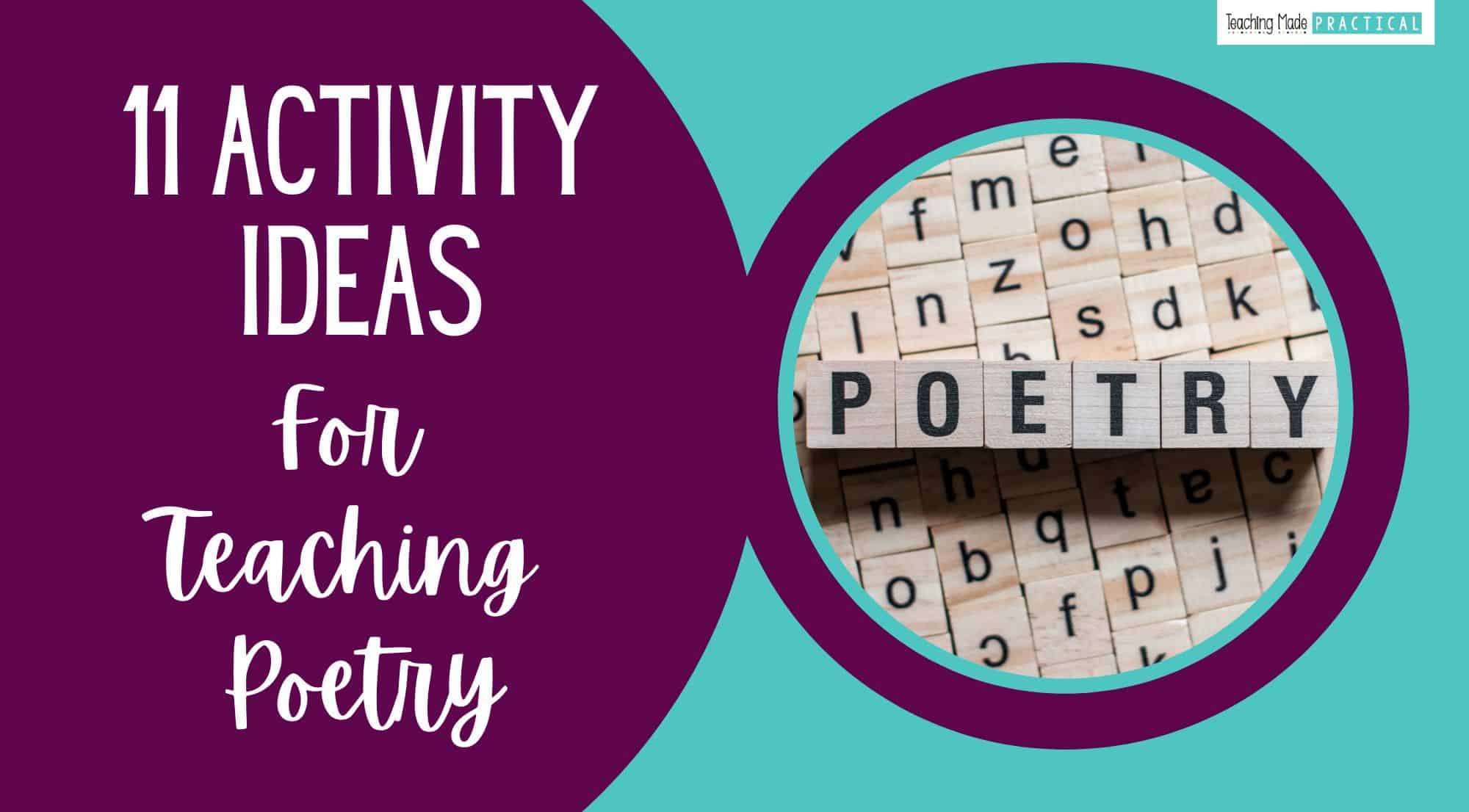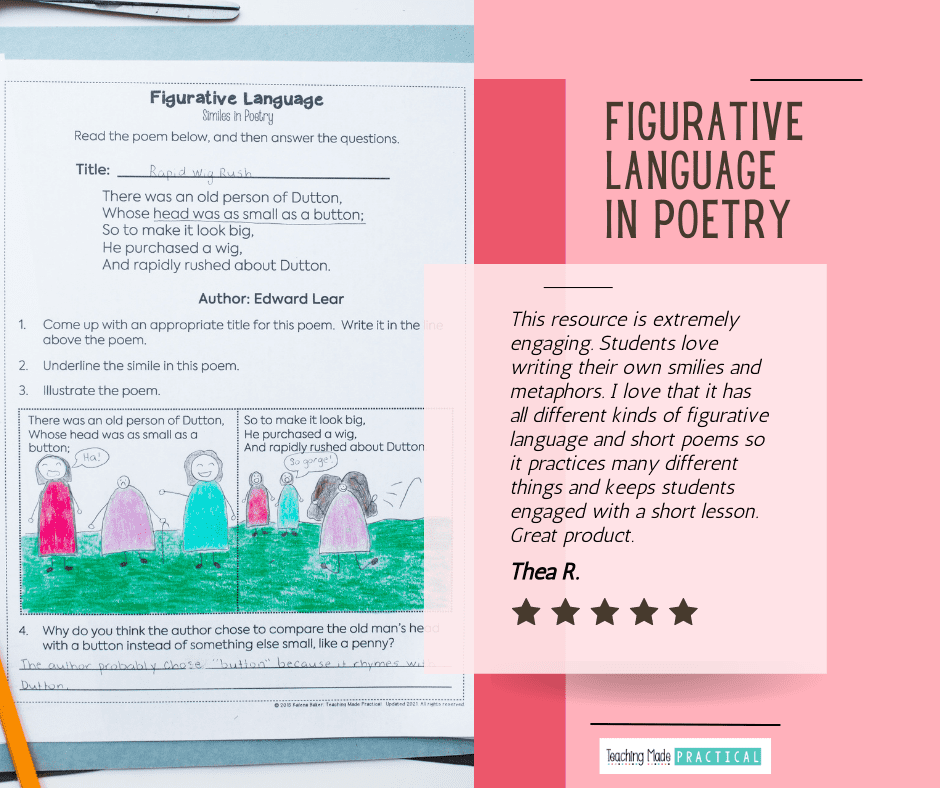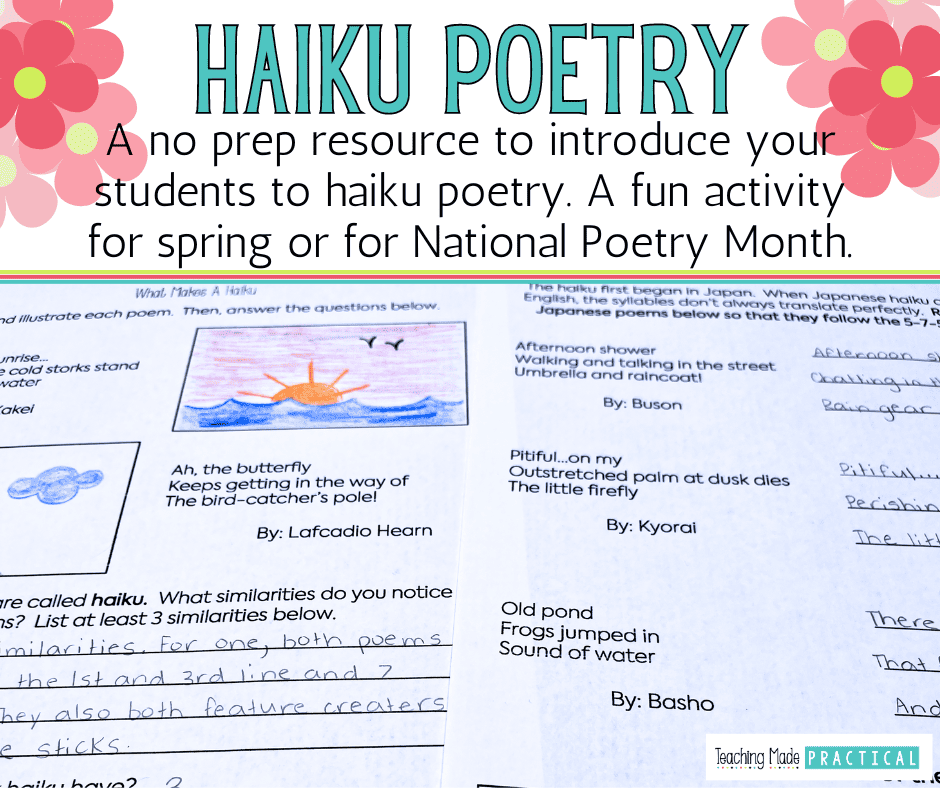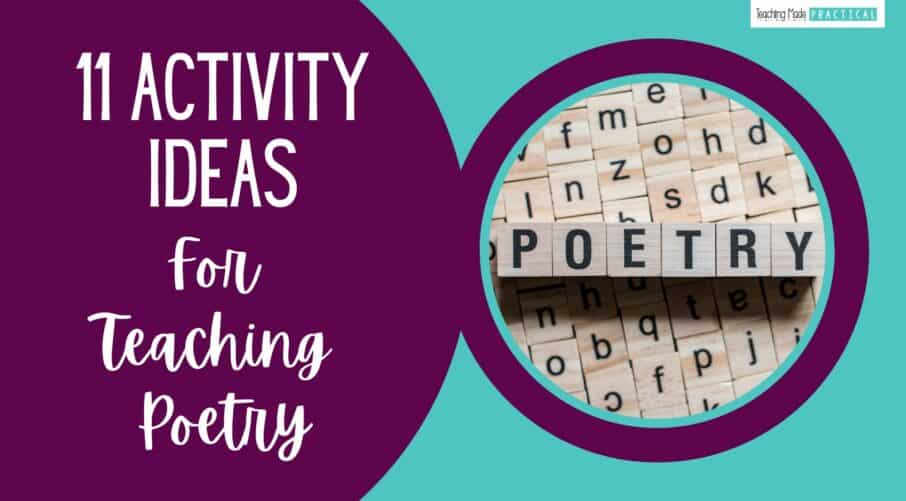
Are you wanting to celebrate National Poetry Month with your 3rd, 4th, or 5th grade students, but not sure where to start? Check out the 11 ideas below.
There are no prep lesson activities, poetry lessons that will take you and your students outside, poetry book suggestions, easy bulletin board display ideas, tips for teaching students to write their own poems, and more!
Below, I sometimes recommend a resource that can be found on Amazon. These links are affiliate links - should you choose to buy, I might get a small compensation at no cost to you.
Poetry Lessons, Ideas, and Activities for Upper Elementary Classrooms
1. Leaf Shape Poem
Take a quick trip outside and have each of your students find one leaf. Have them trace that leaf on a sheet of paper, and then write a poem about leaves or trees inside the tracing.
If you like this, then check out these other lesson ideas for teaching outdoors.
2. Create a Poetry Book
Having students write their own poems is one of the best ways to celebrate Poetry Month! If students are new to writing poetry, however, this can be intimidating.
Poetry writing templates are an ideal way to scaffold so that students do not get too overwhelmed. Have students use the templates in this No Prep Poetry Writing Packet to write 13 different types of poems. Then, bind all the poems together to easily create a poetry book!
Want to make your own templates? Here are 9 different types of poetry that are great for beginning poets.
3. Name Acrostic Poem
4. Make a Shel Silverstein Poet-Tree
Shel Silverstein is well known for his humorous, kid-friendly poetry. You've probably read at least a few poems from one of his popular poetry books - like Falling Up, A Light in the Attic, or Where the Sidewalk Ends.
His website has some useful resources for teachers, including this fun template to create a Poet-tree.
5. Read and Write Poems with Figurative Language
Poems are full of figurative language. Introduce your students to the different types of figurative language, and then go on a hunt for it in poems.
This No Prep Figurative Language in Poetry Resource includes poems that have figurative language so that you don't have to go on a hunt for it yourself! It also includes a figurative language reference sheet as well as guided activities to help your students write their own poems with figurative language!

6. Rearranging Words
These poetry refrigerator magnets were popular when I was growing up. We would use them to leave messages, write silly sentences, and - of course - make short poems!
You can have your upper elementary students do the same thing with words from a newspaper or magazine! Cut out a variety of words and then let students get creative! They can rearrange the words to make one of these short poems of poetry.
Have them glue the words onto a blank sheet of paper and illustrate it for a fun Poetry Month Display!
7. Cloud Poem and Lesson
Read the following poem written by Christina Rossetti to your students. The poem is entitled "Clouds" - but don't tell that to your students.
White sheep, white sheep,
On a blue hill,
When the wind stops,
You all stand still.
When the wind blows,
You walk away slow.
White sheep, white sheep,
Where do you go?
Discuss the poem with your students. What are the white sheep? What is the blue hill? What type of figurative language is this?
After discussing the poem, take your students outside to observe the clouds, and then have them write their own cloud poem!
8. Observe Nature & Write a Haiku
This is another activity that involves a trip outdoors. Introduce your students to haiku - you can use these example haiku for your lesson, or go the no prep route with this Reading and Writing Haiku Packet.
Once your students have been introduced to haiku, take them outside. Have them choose a topic for their haiku and observe it closely. What do they see, smell, touch, and hear? (You might want to leave out taste, although they can imagine!) Then, have them write a haiku!
The No Prep Reading and Writing Haiku Packet has a brainstorming page and template to walk students through the process of writing a haiku.

9. Read Poetry
An obvious option, but one that definitely shouldn't be neglected!
Not sure what poetry books to start with? Check out my favorite haiku books for upper elementary students.
Another good option is to get a good poetry anthology that includes carefully selected poems from a variety of different authors. Two of my favorites are The Randomhouse Book of Poetry for Children and Sing a Song of Popcorn.
Or, try one of these popular poetry books for 3rd, 4th, and 5th grade students:
10. Use Poetry to Build Fluency
Reading and rereading poems is a great way to practice fluency with your 3rd, 4th, and 5th grade students. Poems often have a distinct rhythm that students will naturally want to read smoothly.
You can have students simply reread poems repeatedly to different partners, or ask students to each memorize a different poem and present it to the class.
After students memorize their poems, you could:
- video tape them reciting the poems and form a short movie
- have a poetry slam
- have a poetry picnic
- have a poetry cafe
11. Pass the Poem
This is a fun, interactive Poetry Month Activity! Put students in small groups, and have each student start off with a blank page.
On the blank page, have each student start a poem - but only write the first line! Then, have the students pass their page to their clockwise neighbor. They will read what has already been written, and then write the 2nd line before passing the page again clockwise.
Each student adds one line to the poem until everyone in the small group has written on everyone's paper.
Providing students with a structure for their poems before beginning will help your students that might be overwhelmed by this task. You can provide the rhyme scheme (for example, AABB), or you could provide rhyming words for students to include in their poems. Use these 9 different types of short poems for inspiration.
This is a great activity for making writing fun outside of poetry as well!
Never Stress Over Sub Plans Again!

Make copies, find a fiction book, and you'll be ready for any emergency that comes your way!

